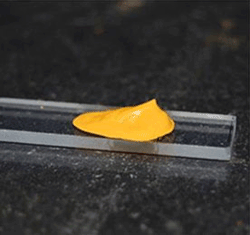Team at Notre Dame successfully demonstrates unique alternative energy concept
A group of researchers at the University of Notre Dame have successfully created an effective – and inexpensive – form of “solar paint.”

A glob of the team’s “solar paint.”
The idea behind this concept is that consumers can coat the outside of their homes with the paint to collect and generate electricity from sunlight. The electricity can then, in turn, be used to power appliances and devices on the inside.
Here’s how:
“By incorporating power-producing nanoparticles, called quantum dots, into a spreadable compound, we’ve made a one-coat solar paint that can be applied to any conductive surface without special equipment,” explains Prashant Kamat, John A. Zahm Professor of Science in Chemistry and Biochemistry and an investigator in Notre Dame’s Center for Nano Science and Technology, who leads the research.
The announcement, first reported in the journal ACS Nano , explains that nano-sized particles of titanium dioxide were coated with either cadmium sulfide or cadmium selenide, and then suspended in a water-alcohol mixture to create a paste.
When the paste was brushed onto a transparent conducting material and exposed to light, it created electricity, though not that much:
“The best light-to-energy conversion efficiency we’ve reached so far is 1%, which is well behind the usual 10% to 15% efficiency of commercial silicon solar cells,” explains Kamat. As such, he and the rest of the solar paint team will continue to study ways to make it more efficient and improve the overall stability of the material, which they’ve aptly titled, Sun-Believable .
Why this concept might actually work:
While the jaw dropper here is certainly the fact that these researchers successfully created a paint capable of generating electricity, what’s particularly noteworthy is the fact that they were able to manufacture it cheaply and in large quantities.
For this reason it stands to make a fairly significant and almost immediate impact when it comes to meeting the general consumer’s energy needs, who is likely to find the material to be a much more cost-effective alternative energy solution than having solar panels installed on the roofs of their homes. ■
Reference for this article via:
newsinfo.nd.edu/news/28047-notre-dame-researchers-develop-paint-on-solar-cells
Advertisement
Learn more about Electronic Products Magazine





